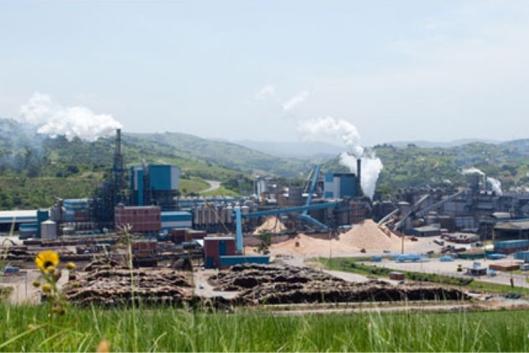During the Apartheid era many South Africans were deprived of their traditional land through laws that led to their displacement – often through forced removals - into remote smaller areas with marginal agricultural potential. At the same time, the South African government of the day was busy converting land taken from rural communities to establish vast monoculture plantations of alien trees, with the intention of supporting a pulp and paper industry that would help to reduce dependence on imported products, as well as reduce exposure to trade sanctions.
A state-owned company called SAPPI – South African Pulp and Paper Industries – was established to implement the plan, and although the company was later privatised, the South African government still holds a substantial stake through the IDC (Industrial Development Corporation). Now known as Sappi Ltd, with various subsidiary companies, it has grown into a huge multi-national corporation, with vast land and equipment assets spread across the planet.
Recently, Sappi has shifted its focus away from paper production towards manufacturing chemical cellulose, for which it appears there is potential growth in demand, mainly from China. With a view to capturing a slice of this new market Sappi has embarked on a major transition process involving selling or closing down a number of its smaller or older mills, which caused major health problems in the areas where they were situated, besides leaving a legacy of polluted land and water.
Part of this process involves enlarging and converting two large mills in SA, as well as one in the US, to chemical cellulose production, which will require increased supplies of cheap raw material in the form of eucalyptus logs. In South Africa, the Sappi mill at Ngodwana in Mpumalanga province has been converted and considerably enlarged, and will now require much more eucalyptus wood as feedstock. This means that besides creating new eucalyptus plantations, existing pine plantations now need to be converted to eucalyptus, which has far worse environmental impacts, especially in terms of water consumption and invasiveness.
However the existing Sappi Saiccor cellulose mill (1) at Umkomaas in KwaZulu-Natal province has been substantially expanded, increasing its production capacity to nearly a million tonnes per annum and this has led to Sappi going on an aggressive campaign to obtain more timber from nearby sources.
It is a general principal that in order to be profitable for the company from a transport cost point of view, logs need to be procured from within a distance of 250km from the mill. This has meant that large areas of local community land within the so-called “catchment” of the mill have been targeted for the establishment of new plantations.
The Sandanezwe (2) (coincidentally also the name of an invasive weed – Chromolaena odorata) plantation in the Ingwe area is one such project that will take 405 ha community land that is on the government allocation list for new plantations in the Umkomaas catchment area. Projects like this have been driven by Sappi and the government using so-called ‘community development’ consultants like Awethu Forestry Investments (Pty) Ltd and NGOs such as LIMA, with strong ties to the timber industry.
Special concessions have been made for these projects based on the argument that the local community had itself requested permission for the plantation, while in reality it was Sappi working behind the scenes and misinforming the local leaders, who actually submit the licence applications to government! The claimed financial benefits of plantations are emphasised, while neglecting to mention any of the negative social and environmental impacts that would have to be paid for by local people and future generations who would lose their rights to land and water.
(1) Engineering News: Sappi to issue notes for bond payment, expansion
http://www.engineeringnews.co.
(2) Draft Review: Ingwe IDP 2013/2014, http://www.ingwe.gov.za/
By Wally Menne, Timberwatch Coalition, e-mail: plantnet@iafrica.com
